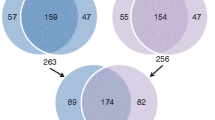Abstract
A new polymorphism, Pc, has been identified in human saliva. Two proteins, Pc 1 and Pc 2, are determined by alleles Pc 1and Pc 2, respectively, which show autosomal codominant inheritance. No null phenotype has been encountered in 225 randomly collected salivas. The frequencies of the two alleles differ in the Black and White American populations, with Pc 1and Pc 2being 0.670 and 0.330 in the Black (N=47) and 0.461 and 0.539 in the White (N=178) populations, respectively. The alleles are in equilibrium in the two populations and segregation analyses (30 families) do not suggest the existence of a null allele in either population. Of seven polymorphic human salivary proteins determined by genes in the salivary protein complex (SPC), Pc phenotypes show association only with Ps phenotypes. Based on that association, our linkage studies, and the biochemical similarities with other SPC proteins, we tentatively conclude that Pc is a member of the SPC, bringing the total number of genes in that group to 13.
Similar content being viewed by others
References
Anderson, L. C., Kauffman, D. L., and Keller, P. J. (1982). Identification of the Pm and PmS human parotid salivary proteins as basic proline-rich proteins. Biochem. Genet. 201131.
Azen, E. A., and Denniston, C. (1980). Polymorphism of Ps (parotid size variant) and detection of a protein (PmS) related to the Pm (parotid middle band) system with genetic linkage of Ps and Pm to Gl, Db, and Pr genetic determinants. Biochem. Genet. 18483.
Azen, E. A., and Yu, P. L. (1984). Genetic polymorphism of CON 1 and CON 2 salivary proteins detected by immunologic and concanavalin A reactions on nitrocellulose with linkage of CON 1 and CON 2 genes to the SPC (salivary protein complex). Biochem. Genet. 221.
Azen, E. A., Hurley, C. K., and Denniston, C. (1979). Genetic polymorphism of the major parotid salivary glycoprotein (Gl) with linkage to the genes for Pr, Db, and Pa. Biochem. Genet. 17257.
Bennick, A. (1975). Chemical and physical characteristics of a phosphoprotein from human parotid saliva. Biochem. J. 145557.
Carlson, A. J., and Crittenden, A. L. (1910). The relation of ptyalin concentration to the diet and to the rate of secretion of the saliva. Am. J. Physiol. 26169.
Dubois, M., Gilles, K. A., Hamilton, J. K., Rebers, P. A., and Smith, F. (1956). Colorimetric method for determination of sugars and related substances. Anal. Chem. 28350.
Friedman, R. D., and Karn, R. C. (1977). Immunological relationships and a genetic interpretation of major and minor proteins in human parotid saliva. Biochem. Genet. 15549.
Goodman, P. A., and Karn, R. C. (1983). Human parotid size polymorphism (Ps): Characterization of two allelic products, Ps 1 and 2, by limited proteolysis. Biochem. Genet. 21405.
Goodman, P. A., Yu, P. L., Azen, E. A., and Karn, R. C. (1982). Probable location of a large block of salivary protein genes on human chromosome six. Am. J. Hum. Genet. 34:182A.
Karn, R. C., Rosenblum, B. B., Ward, J. C., Merritt, A. D., and Shulkin, J. D. (1974). Immunological relationships and post-translational modifications of human salivary amylase (Amy1) and pancreatic amylase (Amy2) isozymes. Biochem. Genet. 12485.
Karn, R. C., Friedman, R. D., and Merritt, A. D. (1979). Human salivary proline-rich (Pr) proteins: A posttranslational derivation of the phenotypes. Biochem. Genet. 171061.
Karn, R. C., Goodman, P. A., and Yu, P. L. (1983). Description of a new human parotid salivary protein polymorphism, Pc. Am. J. Hum. Genet. 35:46A.
Kauffman, D. L., and Keller, P. J. (1983). Relationship of the basic glycoprotein to the basic proline-rich proteins in human parotid saliva. Arch. Oral Biol. 2861.
Merritt, A. D., and Karn, R. C. (1977). The human α-amylases. Adv. Hum. Genet. 8135.
Nakamura, G. R. (1953). Microdetermination of phosphorous. Anal. Chem. 241372.
Yu, P. L., Schwartz, R. C., Merritt, A. D., Azen, A. E., Rivas, M. L., Karn, R. C., and Craft, M. A. (1978). Linkage relationships of the proline-rich salivary proteins (Pa, Pr, Db). Cytogenet. Cell Genet. 22655.
Yu, P. L., Karn, R. C., Merritt, A. D., Azen, E. A., and Conneally, P. M. (1980). Linkage relationships and multipoint mapping of the human parotid salivary proteins (Pr, Pa, Db). Am. J. Hum. Genet. 32555.
Author information
Authors and Affiliations
Additional information
This study was supported in part by PHS Research Grant 1 R01 DE05684. PAG was supported by NRSA Training Grant 5 T32 DE07043.
Rights and permissions
About this article
Cite this article
Karn, R.C., Goodman, P.A. & Yu, PL. Description of a genetic polymorphism of a human proline-rich salivary protein, Pc, and its relationship to other proteins in the salivary protein complex (SPC). Biochem Genet 23, 37–51 (1985). https://doi.org/10.1007/BF00499111
Received:
Revised:
Issue Date:
DOI: https://doi.org/10.1007/BF00499111




